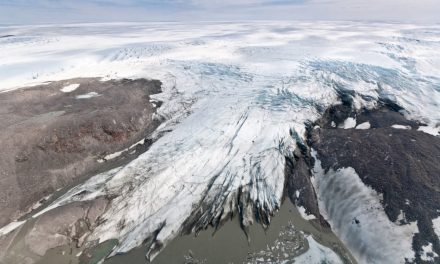Written by Robert Hunziker
Sea level has been stable, at current levels, throughout recorded history for 5,000 years. That’s about to change. Still, it’s very difficult for people to imagine a change in sea level after 5,000 years of rock solid stability.
Nevertheless, assuming sea levels do rise markedly, one of the biggest questions of the century is whether the world is prepared for sea level rise?
As a guess, the answer is: No, not even close.
Well, they better start making plans because there’s no stopping at 410 ppm CO2 and +1°C post-industrial temperature, sea level rise is locked and loaded. It’s only a matter of when how much.
A recent scientific forum offers insight. In February 2019, John Englander, oceanographer and world-renown sea level expert, spoke at The Royal Institution, London, which is affectionately called “the home of science.” It’s one of the world’s most prestigious and long-standing institutions.
The Royal Institution has promoted scientific breakthroughs and new theories for 220 years. In 1859, Prof. John Tyndall spoke at the same spot and same desk where John Englander stood to deliver his speech. Tyndall was one of the first scientists to theorize the impact of greenhouse gases (GHG) on climate change.
One hundred-sixty-years later, John Englander spoke about the consequences of Tyndall’s observations, the onset of sea level rise: “We really can’t wait for the tragedy to evolve to deal with it.” Unfortunately, “We tend to make big changes and expensive projects when tragedy has happened… But, with this one, we really can’t wait for the tragedy to unfold to begin to deal with it. And, therein lies a particular challenge for all of us.”
Accordingly, sea level rise should be the most important consideration for thousands of coastal communities around the world. And, not only that, but surprise, surprise! Sea level rise is a regular, normal feature in Earth’s climate history of the past 400,000 years. In fact, major instances of sea level rise happened four times during that time.
The four-glacial/interglacial periods of the past 400,000 years happened at the rate of one per 100,000 years with four Down (cold) Cycles each lasting 80,000 years and four Up (warm) Cycles each lasting 20,000 years.
The last Down (cold) Cycle ended 22,000 years ago. Thus, and therefore, today is the tail end of the last Up (warm) Cycle and a new Down (cold) Cycle should already be here, but, no, human greenhouse gases (GHG) like CO2, methane, and nitrous oxide have altered the normal rhythms of the planet, stopped dead in its tracks, preventing another long overdue Down (cold) Cycle.
Englander claims there won’t be another Down (cold) Cycle as long as people exist on the planet. People are “heat machines.” They have changed the planet’s chemistry and physics and thus, artificially extended the Up (warm-to-hot-to-hotter) Cycle.
The paleoclimate record shows temperatures over the past 400,000 yrs ranged plus/minus 5°C and CO2 ranged 180 ppm to 280 ppm.
Today’s CO2 at 410 ppm literally smashes the old record of 280 ppm that stood for 400,000 years. Hmm.
Over those 400,000 years, 5°C temperature change brought 120 meter (394 feet) sea level changes in its wake. Looked at another way, sea level rise equals 20 meters (60 feet) per 1°C temperature increase. Uh-oh! Earth’s already heated that much. Does this mean 20 meters (60 feet) of sea level rise is already “baked in the cake,” ready to burst forward?
Well, yes, but not exactly, the key ingredient is when it happens because timing is tricky. In days of yesteryear when 280 ppm was top end, CO2 grew at a rate 0.1 to 0.3 ppm/annum, so sea level rise took centuries as temperatures slowly increased, whereas today, CO2 at 410 ppm and growing 3.0 ppm/annum (10xs the paleoclimate rates) is like a turbo-charged Indy race car on a geological track, and it has powered ahead, thus leaving sea level rise choking on fumes. But, it’ll catch up…count on it. Thus, there’s a lag time between GHGs today and temperature rise and sea level rise tomorrow.
Think of Earth, the biosphere, as a big oven, similar to the one at home, when turned to 450°F, the home oven takes several minutes to crank up to 450°F. It’s not instantaneous. Similarly, the biosphere oven receives tons and tons of greenhouse heat-trapping gases, but its version of “several minutes” is “several years-to-decades” to achieve maximum heat. In other words, your 2010 auto exhaust generated today’s global warming.
It’s all about “timing.” After all, when warming cycles happen, sea level rise usually takes centuries and centuries to increase. For example, 14,000 years ago an increase in temperatures took seas up 65 feet over 400 years. Accordingly, that’s 1.5 feet per decade, which calculation, in part, led John Englander to make the assumption that today’s sea level rise will be 1-2-3 feet by mid 21st century. In turn, that would be a real shocker, especially to the Intergovernmental Panel on Climate Change (IPCC) with its median expectation of one-half a meter or 1.6 feet by 2100.
The IPCC’s absolute “worst-case” guesstimate is 32 inches by 2100, but a footnote hidden in fine print says the IPCC does not factor Antarctica into their calculations. Ahem! Antarctica is not included! Mercy!
Englander’s key points:
1. Sea level never rises smoothly. It’s not a straight line or a curved line. There are inflection points when it suddenly rises. So far, that has not been experienced. In fact, over the past 100 years, temps are up 1°C and sea level rise is only up 4 inches.
2. Sea level has been stable, at current levels, throughout human recorded history for 5,000+ years.
3. Thus, it’s very difficult for people to imagine a change in sea level, especially after 5,000 years of rock solid stability.
Today’s big problem: Sea levels are now (today) at an early stage of exponential growth, meaning, the rate of growth is doubling, cycle-by-cycle, for the first time in known history. Based upon satellite recordings since 1993: sea level rise 1993-98 +1.5MM/yr. 1998-2011 +3.2MM/yr. 2011-2018 5.0MM/yr. That’s nearly double every cycle, which is an exponential function, and it’s trouble, very-very big trouble.
The exponential: “The greatest shortcoming of the human race is our inability to understand the exponential function.” (Albert Allen Bartlett, 1923-2013 /Harvard PhD, Professor Emeritus, Nuclear Physics, University of Colorado at Boulder)
An exponential, to wit: How long does it take to fill Yankee Stadium with water, assuming 1 drop of water is added, then 2 drops, then 4 drops, then 8 drops, then 16 drops, on and on, doubling the number of drops every minute? Answer: 47 minutes.
Exponential is fast, real fast, and sea level rise is now on an exponential pathway for the first time ever!!! That’s a very big pill to swallow! But still, timing is everything, which nobody knows for certain.
Meantime, the sources of sea level rise are readily identifiable as Greenland 24 feet and Antarctica 186 feet and another 3 feet in glaciers found in Alps and around the world in mountainous terrain.
Greenland is surprisingly big. Englander has been there 6 times; it’s 1,600 miles north to south and 1,000 miles east to west. It’s the biggest island in world with ice 2 miles thick that covers 80% of the island.
Antarctica is even more enormous at 7xs Greenland. There are four parts to Antarctica:
1. East Antarctica – relatively solid but starting to rumble – it’s the final frontier of global warming
2. West Antarctica – glaciers go under water here and a high risk zone
3. Antarctica Peninsula- melting the fastest and closest to South America
4. Ice Shelves – thick ice slabs resting on the water, serving as backstops to glaciers- increasingly breaking off in ever-bigger chunks, e.g., Antarctica’s Iceberg B-15 at 183 miles long by 23 miles wide.
With mounting concerns expressed by scientists, six Antarctic glaciers are under special watch: Pine Island Glacier – a huge cavity discovered only recently – Thwaites Glacier-a new disturbing discovery found only recently, Haynes Glacier, Pope Glacier, Smith Glacier, and Kohler Glacier. All of these glaciers are located around the Amundsen Sea. Combined, these six have 10 feet of sea level locked up inside. Nobody knows when, but the entire region is extremely vulnerable, already showing the early signals of “losing it.”
Meanwhile, Englander’s guesstimate: By mid century, we could get a couple of feet of sea level rise. But keep in mind it doesn’t happen all at once. It’s the buildup that destroys, and that is now, unfortunately, on an exponential pathway. In other words, it’s an extremely dicey affair that could be gradual, or it could be rapid, awful, and nasty.
Englander’s conclusion: Sea level rise is unstoppable.
Interestingly, ever since the 1990s, mainstream science has been at least 30 years late with sea level projections, consistently way too low, but then again, exponential growth throws off the best of ‘em. It’s a wild card.
According to Englander, there are three key takeaways from his speech:
1. Reduce emissions, immediately – it’s most important to slow warming as much as possible as early as possible.
2. Regardless, sea level rise will still be catastrophic on a global scale. Even with 100% renewable energy tomorrow, sea level rise will happen. As an aside, oceans (2/3rds of the planet) absorbed 85% of planetary heat and emit CO2 when too warm/hot.
3. The sooner “engineering for the future” happens, the easier to adapt.
According to Englander, society has 20-30 years to redesign cities to prepare for the inevitable as thousands of coastal communities must move or adapt to sea level rise. As an aside, and in fairness to contrary opinion, there are scientists that disagree with the timeline of 20-30 years to do something.
The risk factor is heightened by the fact that past sea level rises had saw-toothed patterns with inflection points of rapid increase along the way, making it nearly impossible to predict timing.
As such, and here’s the big oops-a-daisy, with exponentials kicking into gear, it’s truly a gamblers’ world.
According to John Englander, there are no options. It must be dealt with. Come hell or high water, sea level rise is forthcoming.













